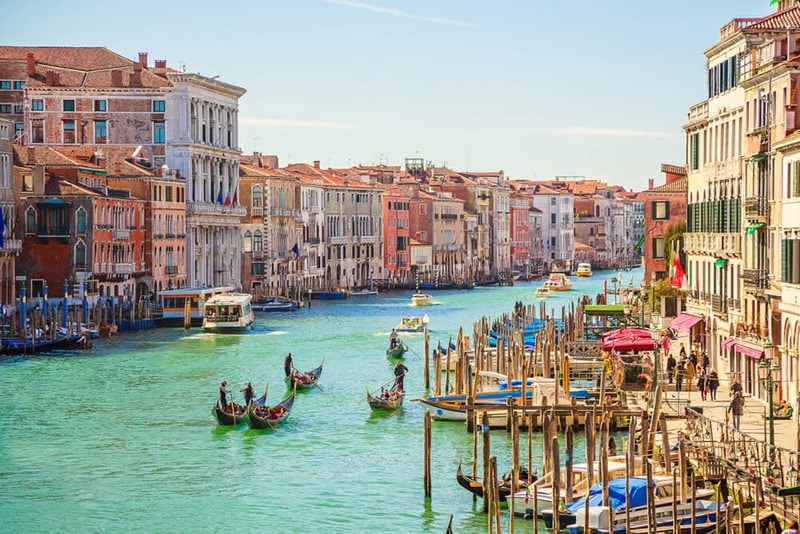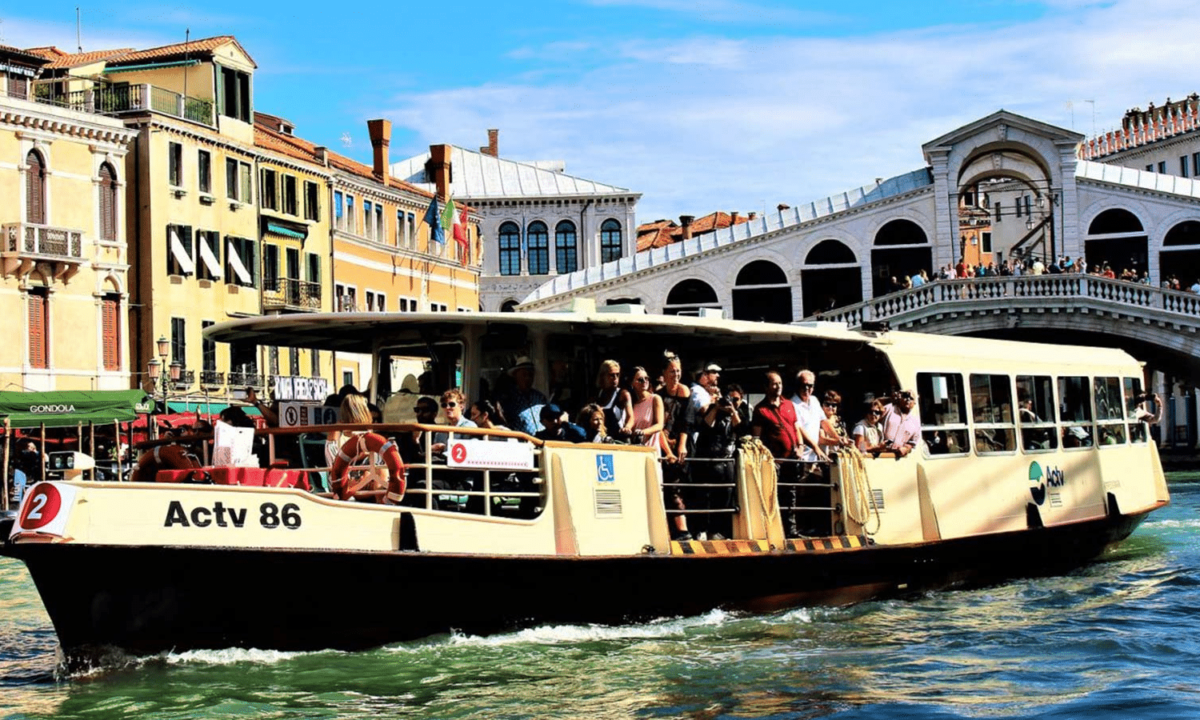This Venice guide will introduce you to this magnificent historical city in Italy. Furthermore, we will show you what to visit, where to sleep, when to go, and much more. Ultimately, we will share some valuable tips to make your planning effortless. So, stay with us if you’d like to learn more.

©paesionline.it
Our website may contain or contain copyrighted material that the copyright owner has not explicitly authorized. We believe using materials on this site constitutes a ‘fair use of any such copyrighted material (referenced and provided for in section 107 of the U.S. Copyright Law). So, please read our legal disclaimer document for more information about our disclaimers.
Venice Guide: Introduction
Venice is a beautiful city located 4 km away from the mainland, in the vast Adriatic Lagoon that bears its name. It is known for its picturesque, evocative, and unique atmosphere. Water is present everywhere in the city, with canals. These buildings come from the sea: vaporettos, motorboats, boats, and famous gondolas.
People often call Venice the city of love, combining art, beauty, landscape, and atmosphere in a unique and perfectly harmonious mix. Watching the sunset over the Lagoon, walking through the streets, enjoying a Bellini at Harry’s Bar, or trying a cicheto and a shade in a characteristic Venetian bacaro are all things that tourists will remember as some of the most beautiful moments of their visit to the city.
And, if you visit during the Carnival, you will experience something unique and memorable.
Go there if you like: museums, monuments, events.
How long: a weekend.
The best time: all year round.
Know before you go.
Important information about Venice:
– Currency: Euro
– Safe and highly walkable city
– Signs on street corners indicate directions
– Vaporetto pass for easy waterbus access
– Traghetto gondolas for a cheap Grand Canal crossing
– Acqua alta can occur in October/November
– Book well in advance for Carnevale (Feb/Mar)
Where is Venice
Venice’s historic center comprises 118 islands connected by bridges and separated by canals. The city has six districts extending around the Grand Canal. Venice became a maritime republic governed by a “doge” in the 7th century. It became the queen of the Mediterranean in medieval times, rivaled only by Genoa. Its independence ended with Napoleon and the Austrians.

©paesionline.it
What to know
Firstly, Venice is a city of art with incomparable cultural and artistic significance. It is also a vital university location. Secondly, boat trips in the Lagoon and gondola rides offer the opportunity to admire enchanting views of the city and, simultaneously, to have a unique, different, and exciting experience.
Thirdly, it is A city of symbols, and one of the most important meeting places is most likely the splendid St. Mark’s Square with its Basilica.
Venice is rich in historical and artistic beauties of high cultural value. Indeed, it can be considered the city of bridges. In addition to the St. above Mark’s Square, the Rialto Bridge, the Bridge of Sighs, the Doge’s Palace, the Clock Tower, the Church of San Giovanni e Paolo, the Church of Santa Maria del Giglio, and the Bell Tower of San Marco are worth visiting.
Among the canals to walk and observe, we recommend Cà Rezzonico, Canale Grande, Cà Pesaro, Cà d’Oro, and many others. But Venice also rhymes with museums: the Peggy Guggenheim Collection, the Gallerie dell’Accademia, the Correr Museum, the La Biennale di Venezia Theater, and a visit to the surrounding area in the beautiful Murano and Burano cannot be missed. That’s why this Venice Guide will try to introduce you to this magnificent pearl as much as possible.
Note: Read our related article about Venice’s main attractions for more detailed information. You can also check The Perfect Trips from Venice to see what is fascinating about this city.
Don’t miss
Visit the island of Sant’Elena if Venice is too crowded. It’s a local neighborhood near St. Mark’s Square, and you can relax in the Giardini Pubblici gardens. Santa Maria dei Miracoli is a small marble church with beautiful carvings. To avoid queues at St. Mark’s bell tower, visit San Giorgio Maggiore and its peaceful church. The Museo Correr is the Museum of Venice and introduces the city’s history. You can see coins, banners, and costumes, and learn about the fancy stacked high heels courtesans wore during the aqua alta.
How to get to Venice and how to move around.
Firstly, this city is unique; therefore, the way to reach it is also particular. We invite you to read our related article about Transport in Venice, which forms part of our Venice Guide.
Our website includes affiliate links. So, remember that we may receive commissions when you click our links and make purchases. Please read our legal disclaimer document for more information about our Affiliate disclaimer and other disclaimers like the Fair-Use disclaimer.
Where to stay in Venice
Remember two things when visiting Venice: it is on the water and very old. These bring some practical considerations that must be addressed. How far will you have to walk? Are you taking a water bus? Do you have accessibility needs? There are a lot of stairs in Venice. Before you book, there are several key factors to check and consider to avoid unpleasant surprises once you arrive.
Let’s first get San Marco out of the way. This sestiere has the popular gems of tourist Venice and is by far the busiest area. This neighborhood is a must-visit. Sites: the Basilica di San Marco, the Doge’s Palace, the Bridge of Sighs (all those prisoners crossing from the court to the prison), the Rialto Bridge (the famous one you see over the Grand Canal), and St. Mark’s Square. Eventually, everyone ends up in this area. So, if you stay there, everything will be close to you. The minuses are that it gets very crowded and, of course, pricey.
For budget travelers, we recommend staying outside the city, Mestre or even Padova, another big and exciting city just 20 km away from Venice. Of course, you will have to spend some money on additional transport. Still, you will get to enjoy a cozier and cheaper apartment.
When to Go to Venice
Venice’s peak travel months are April, May, June, September, and October. Late spring and autumn are the best times to visit Venice. In winter, you can enjoy the city covered in snow. Spring offers ideal weather. Summer is vibrant but crowded, with occasional unpleasant smells. Autumn is an excellent option for travelers who prefer to avoid summer crowds.
Helpful Venice Guide safety tips.
Most importantly, the city is generally safe. However, watch out for petty theft and pickpocketing, especially in crowded tourist areas and on public transportation. If you’re worried about scams, be aware of common travel scams. Solo female travelers should follow standard safety precautions. Choose accommodations in the upper part of town to avoid flooding. In case of emergency, dial 113. Make copies of your documents and share your itinerary with loved ones. Consider purchasing travel insurance for comprehensive coverage.

©paesionline.it
Here are some helpful travel tips for visiting Venice.
In this Venice Guide, we’d like to give you a few tips and hints. So you could plan your trip better. Firstly, please remember the following tips for your trip to Venice:
- Plan your visit
Firstly, the most important thing is careful planning. Therefore, consider visiting during off-peak seasons (late autumn to early spring) to avoid crowds and enjoy a more authentic experience.
Advanced booking
Book your accommodation in advance, as hotels and Airbnb properties in Venice can fill up quickly. Staying near central attractions like Piazza San Marco is convenient, but staying in quieter neighborhoods can give you a more local experience.
Venice Car or a tourist pass
Purchasing a Venice Card or a Venice Tourist Pass is worth considering if you plan to visit Venice. These passes offer discounts on public transport, museums, and other attractions, making them a cost-effective option for travelers. The Venice Card, in particular, includes unlimited use of the Vaporetto (water bus) system, an essential transportation method for getting around the city.
Avoid the crowds
To avoid crowds at famous sights such as St Mark’s Basilica and Doge’s Palace, plan to visit them early or late in the evening.
Skip the queue by buying tickets in advance.
Booking tickets in advance or attending a guided tour can also help avoid queues.
Local customs
Respect local customs and etiquette, such as covering your shoulders and knees when entering churches, not sitting on the steps of monuments, and being mindful of noise levels in residential neighborhoods.
Responsible traveling
Be a responsible traveler, minimize plastic waste, avoid excessive noise, and be mindful of the fragile ecosystem. Venice faces environmental problems such as over-tourism and rising sea levels, so respecting the city and its residents is crucial.
The Venice guide – FAQs
How long do you spend in Venice?
Spend 2-3 days in Venice, not just a day trip. A more extended stay allows you to enjoy the city at a slower pace, which is helpful with the crowds.
Is Venice expensive for the average traveler?
Venice is one of the most expensive cities in the world. However, you can still visit without spending a lot of money.
Murano island

©paesionline.it
Do I need to pre-book attractions in Venice?
We highly recommend pre-booking major tourist attractions like Doge’s Palace in Venice. You can still visit without a booking. But you will likely have to wait in painfully long queues, especially traveling during the peak summer months. You can book a guided tour or a ‘skip the line’ ticket.
Are there any beaches near Venice?
Venice’s Lido island has a 12-km-long sandy beach, perfect for a relaxing break on a hot and sunny day. Enjoy the sound of the Adriatic waves.
Is Venice a good destination for solo travelers?
Venice is a great city for solo travel in Europe. It’s compact and secure, and Italian hospitality is top-notch.
Do you have to pay to enter the city?
Venice has released its 2024 fee schedule for peak-hour visitors. The fee of 5 euros will apply to day-trippers over 14 years old who are not spending the night. The goal is to encourage longer stays and reduce overcrowding. There are 29 days on which the fee will apply, mostly on weekends from April to July.
Venice Guide – Final Wording
We hope we have given you a glimpse of what Venice is like and what it means to us. Because we genuinely love the city despite its flaws. What about you? Have you ever visited the city? Please share with us your opinions in the comments below.
Take a look at
References and sources:
Photo credits:
Feature photo Credits: ShutterStock



